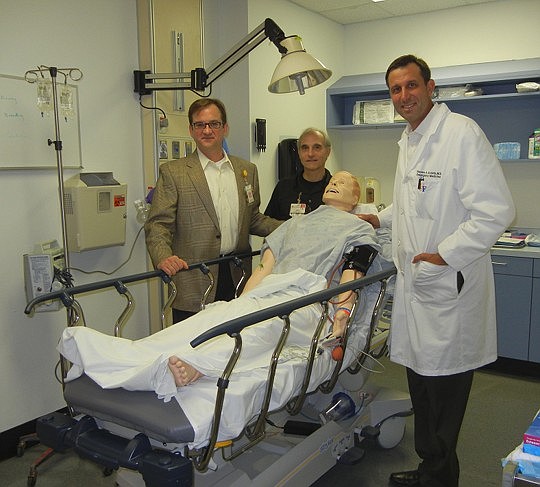
Each year, about 2,000 medical residents and nursing staff spend time tending to sick and injured patients in the emergency and operating rooms at Methodist Hospital.
If they don’t do it correctly the first time, they try again, or as often as necessary.
That’s because the patients are life-like robots that can be controlled technologically to simulate what the center says is “almost every known human physical condition.”
“We are trying to suspend their disbelief that this is not real,” said Dr. Brent Seibel, medical director of Simulation Education for OBGYN.
The University of Florida Center for Simulation Education and Safety Research is housed in the actual ER and OR used by the former Methodist Hospital, which is part of the UF&Shands campus along West Eighth Street just off Interstate 95.
“CSESaR” is a joint effort by Shands Jacksonville Medical Center and the University of Florida College of Medicine-Jacksonville.
The mission of the center is to promote quality patient care, expand patient safety initiatives and enhance multidisciplinary health care, education and teamwork through simulation and goal-directed training.
The 24,000 square feet of space is divided into three areas in the Pavilion building.
There are the main simulation and conference area; the operating room simulation and instruction area including 12 operating rooms; and the disaster simulation area that can be equipped with tents, emergency mobile facilities and disaster preparation equipment.
Because they are functional facilities, they can be used if needed in natural disasters and emergencies.
The simulation allows medical residents and other students to train in a controlled environment before working with human patients. The training is offered to physician residents, fellows and students; nursing students; hospital personnel; medics and emergency responders; local college medical classes; and regional health care providers.
The equipment includes 18 full-body robots that can, among other functions, talk through staff programmers, show vital signs and bleed. Robots can have heartbeats, working arteries and veins, move, talk and breathe. They wear wigs and can be dressed in different clothing to mimic real-life situations.
Female robots can give birth to baby robots. Ultrasound technicians can work on “pregnant” robots.
Along with the full-body robots, the equipment includes simulators of upper torsos and airways, and there also are “body parts” for specific functions. There are simulated bodies and parts for patients from adults to newborns.
There are supply rooms of special parts, too, such as burned and injured limbs and a face with a rod through it. There are mouths with dental issues.
Dr. Andy Godwin is the center’s medical director, as well as the “voice” of some of the patients, and Bruce Nappi is the center’s administrative director.
Godwin said to create a center of its size and scope would cost “tens of millions” of dollars to build and several million to resource and to operate annually. “We do it on a much smaller budget,” he said. It is about $2.5 million a year.
The University of Florida Department of Emergency Medicine began using the simulations in 2002 and over time the functions moved into the vacated ER and OR of the former Methodist Hospital.
The center generally operates from 7 a.m.-6 p.m. Monday-Friday and sometimes on weekends. Nappi counts at least 35,000 “contact” hours a year.
“Everybody has a true belief it makes a difference,” said Godwin.
356-2466